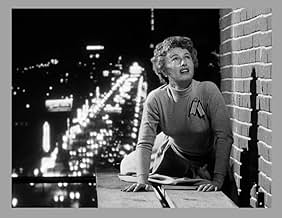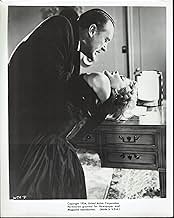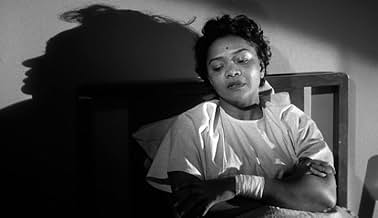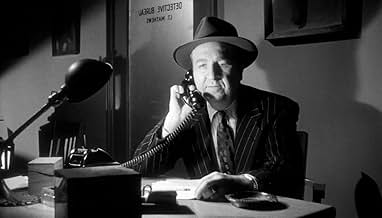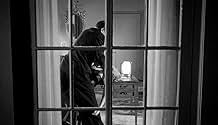IMDb RATING
6.6/10
3.7K
YOUR RATING
A woman's sanity comes into question, after she claims to have witnessed a murder from her apartment window.A woman's sanity comes into question, after she claims to have witnessed a murder from her apartment window.A woman's sanity comes into question, after she claims to have witnessed a murder from her apartment window.
- Director
- Writers
- Stars
Adeline De Walt Reynolds
- The Old Lady
- (as Adeline de Walt Reynolds)
Claude Akins
- Police Officer
- (uncredited)
Ralph Brooks
- Man at Lunch Counter
- (uncredited)
Russell Custer
- Police Officer
- (uncredited)
Sam Edwards
- Tommy
- (uncredited)
Jean Fenwick
- Nurse
- (uncredited)
Fred Graham
- Plainclothes Man
- (uncredited)
- Director
- Writers
- All cast & crew
- Production, box office & more at IMDbPro
Featured reviews
Perhaps Barbara Stanwyck was looking to score another Oscar with Witness To
Murder. Her fourth and final nomination was with Sorry Wrong Number. In
that film she overhears a murder plot.
In this one she sees neighbor George Sanders commit a strangulation on some woman. But the police show up and no body and no signs of struggle. Still Stanwyck persists and detectives Gary Merrill and Jesse White do their best..
We learn too early that Sanders did the deed which robs us of suspense. Still Sanders is at his caddiest and that's always a treat.
The best scenes are Stanwyck in a mental ward and she's in with a lot of those you would have seen in the Snake Pit. Wonderful scene allowing all the players including Stanwyck to overact and stay in character.
Timing is everything and Witness To Murder was released first so it was no copycat. But Alfred Hitchcock's Rear Window with the same premise and all those Hitch touches came out far superior and this film was forgotten.
Stanwyck and the cast do a good job though and Witness To Murder should not be forgotten.
In this one she sees neighbor George Sanders commit a strangulation on some woman. But the police show up and no body and no signs of struggle. Still Stanwyck persists and detectives Gary Merrill and Jesse White do their best..
We learn too early that Sanders did the deed which robs us of suspense. Still Sanders is at his caddiest and that's always a treat.
The best scenes are Stanwyck in a mental ward and she's in with a lot of those you would have seen in the Snake Pit. Wonderful scene allowing all the players including Stanwyck to overact and stay in character.
Timing is everything and Witness To Murder was released first so it was no copycat. But Alfred Hitchcock's Rear Window with the same premise and all those Hitch touches came out far superior and this film was forgotten.
Stanwyck and the cast do a good job though and Witness To Murder should not be forgotten.
I have been a fan of Stanwycks since I was a child (now 55 yrs)..saw and thought I knew most of her films from mid 30's- on to the TV years. Somehow, Witness To Murder escaped me, until I saw it listed to be shown on TCM (thank you Ted), this weekend 11/23, I believe... I set my vcr, and was not disappointed, what an outstanding film noir this is.. yet no one ever mentions or discusses this one !!!Stanwyck is just as good as she was in Sorry Wrong Number, maybe more controlled... Plot is similar to Hitcocks Rear Window, but it has many more twists and turns. Supporting cast is great, including 2 All About Eve alumni.. George Sanders, playing a sadistic Nazi (yes) murderer his best work since Eve, and Gary Merrill, portraying a police detective...You can see future star and Oscar nominee, Juanita Moore, (Imitation of Life '58) in an assylum scene, very effective, and Jesse White, as Merrills partner giving some comic relief... Wow, couldnt stop watching... Great to see this ignored film from mid 1950's. Is it on tape ?? Aside #1: Gary Merrill was married to Bette Davis at the time... She and Stanwyck did not get along...I would have loved to be a fly on the wall when Gary came home from work... during the filming of Witness.
Aside# 2: Stanwyck was the most prolific actress in Hollywood history!! She just kept turning them out. I remember my parents taking us to our local theatre, Regent, in Newark, NJ.. and every other week so it seemed was a Stanwyck movie... We had just seen her in Titanic, and soon she would be in Executive Suite.... what a pro, what a career, what an actress... she was such a family favorite that my older sister was named after her, Barbara......
Aside# 2: Stanwyck was the most prolific actress in Hollywood history!! She just kept turning them out. I remember my parents taking us to our local theatre, Regent, in Newark, NJ.. and every other week so it seemed was a Stanwyck movie... We had just seen her in Titanic, and soon she would be in Executive Suite.... what a pro, what a career, what an actress... she was such a family favorite that my older sister was named after her, Barbara......
The John Alton photography is layered thick and shadowy in this late Film-Noir entry. Almost every scene is back lit with diagonals and impressions draping the proceedings and it is this atmospheric artistic display that highlights this often filmed story.
The characters and conventions of the Noir cycle by this time have become familiar but the shear broad strokes of the style are undeniably effective. The odd take on the villain being of Nazi descent with delusions of grandeur while meant to be of a deep personality flaw, is obtrusive and distracts from believability. It is an unwanted and unneeded take on the psychological persona of the killer.
The mental hospital scene is a standout as is the finale through the construction site. The only drag is the relentless unbelieving of the authorities that wears out its welcome fast but in the long view does not hold the film back from its better parts.
The characters and conventions of the Noir cycle by this time have become familiar but the shear broad strokes of the style are undeniably effective. The odd take on the villain being of Nazi descent with delusions of grandeur while meant to be of a deep personality flaw, is obtrusive and distracts from believability. It is an unwanted and unneeded take on the psychological persona of the killer.
The mental hospital scene is a standout as is the finale through the construction site. The only drag is the relentless unbelieving of the authorities that wears out its welcome fast but in the long view does not hold the film back from its better parts.
"Witness to Murder" is a small but interesting film starring Barbara Stanwyck, George Sanders, and Gary Merrill. By 1954, Stanwyck was 47 and no longer considered leading lady material. However, because she was such a great star and actress, she could still get good roles in big films, "Titanic" and "Executive Suite" being two that leap to mind. She could also, like Loretta Young, get stuck in B movies like this one and "Jeopardy." "Witness to Murder" isn't so much a B movie as it is closer to what one was seeing on television by 1954. And it's not a B cast.
Stanwyck plays a career woman, Cheryl, of a certain age who sees a woman murdered in the apartment across from hers. The apartment belongs to an author, Albert Richter, who emigrated to America after the war. Cheryl reports the murder but no one believes her. Richter is too smooth and always one step ahead of her with the police. Cheryl is considered an hysterical single woman who has delusions because she isn't married and probably going through menopause, though this isn't out and out stated. Completely outrageous and no doubt what actually went on at the time. These assumptions were just taken for granted in the '50s. There was something really wrong with a woman who never married. Read LOSER. A woman's goal in life was marriage; the career was just a stopgap until the ring was on the finger. What must it have been like for an intelligent woman to have that mantle put on her. In this film, the police detective (Gary Merrill) is interested enough in her to at least follow the case.
All of the acting is very good, with Stanwyck really shining as someone determined to get the truth out, even if she has to do a little detective work herself. Sanders is very effective as the villainous Richter, and he's pretty scary at the end of the film. The last 15 minutes or so are exciting and will have you on the edge of your seat.
This is actually a fairly derivative film bolstered by its stars. And you can't beat the opportunity to see the attitudes toward women played out in a realistic manner. Alas, there are still touches of it today.
Stanwyck plays a career woman, Cheryl, of a certain age who sees a woman murdered in the apartment across from hers. The apartment belongs to an author, Albert Richter, who emigrated to America after the war. Cheryl reports the murder but no one believes her. Richter is too smooth and always one step ahead of her with the police. Cheryl is considered an hysterical single woman who has delusions because she isn't married and probably going through menopause, though this isn't out and out stated. Completely outrageous and no doubt what actually went on at the time. These assumptions were just taken for granted in the '50s. There was something really wrong with a woman who never married. Read LOSER. A woman's goal in life was marriage; the career was just a stopgap until the ring was on the finger. What must it have been like for an intelligent woman to have that mantle put on her. In this film, the police detective (Gary Merrill) is interested enough in her to at least follow the case.
All of the acting is very good, with Stanwyck really shining as someone determined to get the truth out, even if she has to do a little detective work herself. Sanders is very effective as the villainous Richter, and he's pretty scary at the end of the film. The last 15 minutes or so are exciting and will have you on the edge of your seat.
This is actually a fairly derivative film bolstered by its stars. And you can't beat the opportunity to see the attitudes toward women played out in a realistic manner. Alas, there are still touches of it today.
It's interesting that both this film and "Rear Window" came out in the same year, since the base plot is identical: person witnessess murder through apartment window in opposing apartment and spends rest of movie trying to convince everone else what they saw. While the Hitchcock movie is more stylish and elaborate, this film definitely keeps your attention. Typical of movies of the 50's, the villain is disposed of in the climax, thereby eliminating any necessity of bringing them to justice. Stanwyck, as usual, gives her best "woman in distress", hysterical performance.
Did you know
- TriviaIn an unusual connection for the time (or possibly a product placement), the W&J Sloan Company in Beverly Hills - where Cheryl worked - was a real furniture and interior decorating firm founded in New York City in 1843. It went bankrupt in 1985. According to the end credits, the company supplied set decorations and furnishings for the film.
- GoofsThe story is taking place in Los Angeles, but the map on the wall in Larry's office is that of San Francisco.
- Quotes
[repeated line]
The Old Lady - Mental Patient: Show Mr. Peabody into the library please.
- ConnectionsFeatured in Frances Farmer Presents: Witness to Murder (1959)
Details
- Release date
- Country of origin
- Languages
- Also known as
- Testigo del crimen
- Filming locations
- Linda Vista Apartments, 939 S. Serrano Ave., Los Angeles, California, USA(Cheryl Draper's apartment building)
- Production company
- See more company credits at IMDbPro
- Runtime1 hour 23 minutes
- Color
- Aspect ratio
- 1.75 : 1
Contribute to this page
Suggest an edit or add missing content

![Watch Trailer [EN]](https://m.media-amazon.com/images/M/MV5BYjI4NDBiYmQtN2U0MS00MTdjLWI0YzEtODBkYjE0YjQ1MDc4XkEyXkFqcGdeQXRyYW5zY29kZS13b3JrZmxvdw@@._V1_QL75_UX500_CR0)
